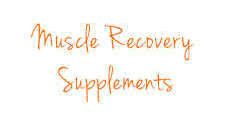Speed Up Recovery After a Workout - Key Supplements to Take

Take Advantage of Natures Supplements
If you're like most fitness athletes, you'll do anything to cut down on recovery time so you can get back into the gym. You may turn to nutritional supplements for that extra boost, but with a
sports supplement market that has been flooded with options over the last decade, it can be difficult to decide which products to buy. Some supplements are sold alone, some are sold in combination
with others, while some contain a virtual laundry list of ingredients. There is very little information on how to use them to enhance recovery.
Rather than just providing [another list of items to buy, I'm going to explain exactly how these supplements work inside the body, as well as the best ways to use them to achieve your goals. Here
are three of the best recovery-enhancing supplements available. They will lessen the amount of rest time needed between workouts.
Antioxidants
Antioxidants have been proven to have a markedly positive effect on the amount of time needed to recover from intense training. This is because they can neutralize free radicals. Strenuous exercise greatly increases the production of free radicals, highly volatile particles that can damage surrounding tissue. The cellular damage caused by this flood of free radicals plays a part in the inflammation and feelings of soreness that follow a hard workout. Supplemental use of antioxidants has been shown to lessen the degree of both muscle soreness and inflammation from exercise.Antioxidants should be taken at precise times to maximize their protective benefits. Free radicals react very quickly with their surroundings, so taking antioxidants only after a workout will have very little influence on post-workout recovery. The free radicals will have already done their damage. It's important to make sure that antioxidant levels are high before beginning a workout. Antioxidants should be supplemented on a regular basis as part of a nutritional program., and extra should be taken 30 minutes to an hour before a workout.
Antioxidants come in both water-soluble and fat-soluble varieties. Examples of water-soluble antioxidants include vitamin C and various polyphenols, while examples of fat-soluble antioxidants include vitamin E, carotenoids and coenzyme Q10. Those that are water-soluble tend to protect extracellular and intracellular fluids, while those that are fat-soluble tend to protect cell membranes. Some antioxidants, such as alpha lipoic acid, are both water- and fat-soluble and protect all of these areas. It is important to supplement with a wide variety of antioxidants to ensure a full range of protection.
Glucosamine
Athletes should also be concerned with their joints and connective tissue. Intense training, especially the kind that includes heavy weight-bearing exercises, can wreak havoc on joints and connective tissue. If this damage is not addressed after each workout, over time it can lead to debilitating joint problems such as osteoarthritis. Glucosamine has become widely recognized for its ability to alleviate joint pain and facilitate the repair of cartilage.Glucosamine stimulates the production of glycosaminoglycans and proteoglycans. With enough of these two substances, which are major components of cartilage cells, damaged cartilage is able to fully rebuild itself. Decades ago this wasn't even believed possible. Glucosamine also stimulates the production of synovial fluid, allowing for better lubrication and shock-absorption within the joint.
Painful inflammation is another unfortunate side effect of intense exercise, caused primarily by the friction generated in the joints during weight-bearing movements. Pain caused by the inflammation from a particularly grueling workout may greatly extend the recovery period. Conventional wisdom prescribes taking over-the-counter non-steroidal anti-inflammatory drugs (NSAIDS) such as naproxen or ibuprofen to alleviate this inflammation, but over the long run these compounds actually exacerbate the problem by inhibiting the formation and repair of the cartilage that line the joint surfaces. Glucosamine, on the other hand, has been proven to be just as effective at reducing inflammation as these over-the-counter drugs without the deleterious side effects.
The amount of glucosamine necessary to combat inflammation and help rebuild connective tissue will vary from person to person, depending upon factors such as body size and workout intensity. However, most successful studies involving glucosamine have shown positive results with as little as 1,500 mg per day.
Phosphatidylserine
Another concern for hard-training athletes is elevated post exercise Cortisol levels. Cortisol production at the beginning of exercise is actually a good thing. Cortisol facilitates glycogen and lipid breakdown for energy, increases blood sugar levels, and improves the functioning of the cardiovascular system. But when training becomes particularly intense, Cortisol can rise to dangerous levels and lead to excess muscle and connective tissue breakdown, increased fat storage, suppression of the immune system, and generally make you feel lousy. The supplement phosphatidylserine has been shown to reduce the amount of Cortisol produced by the body during times of stress by 30 percent or more. Such a reduction would have a remarkable impact on how much time is needed between intense workouts.In addition to the control of excess Cortisol, phosphatidylserine (PS) is an important brain nutrient. As a phospholipid, it keeps the membranes of brain cells functioning correctly, allowing for the proper transmission of neurotransmitters. Supplementing PS has been shown to improve mood and create feelings of well-being.
An effective dosage for the reduction of Cortisol levels during intense training is anywhere from 400 mg to 800 mg. Take 30 minutes to an hour before your workout to let it get into your system before you start your hard training.